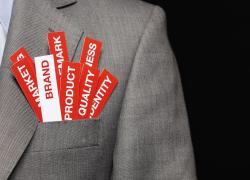So, you need a new website.
While it’s tempting to immediately take this show on the road, there are a lot of questions you need to ask yourself first so that your new website is built to be exactly what you need for your business.
But first, you're probably wondering...
Why do I need to ask these questions?

Reason 1: Scope Creep
Properly preparing for a website redesign will help you define the project and avoid scope creep, or more tasks getting tacked on to an existing project as it moves along. By first hashing out a specific plan for your website, you can make sure your project stays on-course throughout.
Of course, sometimes features come along through the process that you may not have realized were important before the project start, but the more you can determine up front, the better.
A good creative agency will help you define these features and requirements so that they can craft an accurate proposal for the job—as opposed to having someone throw out a high number just because they don’t fully understand the entirety of the scope.
Reason 2: Efficiency
These questions will also make the entire process move along more quickly as your team will know what you want and when, making communication between your brand and the web design agency clear and efficient.
Besides, with the gravity of a project of this scope, you likely will have some tough decisions to make with your team, in which case having a unified front can eliminate friction throughout the process.
Reason 3: Finding the Perfect Fit
Finally, and perhaps most importantly, these questions will help guide your brand to find the right web design agency for the job—ideally, you can get a one-stop-shop approach where you get all the services associated with building a website taken care of by one team that’s dedicated to the project. Then you can get exactly the website you dreamed of—no less, no more.
Here are the 20 most important questions you need to ask yourself before launching into a full-fledged website design—or redesign. There are a lot of factors that go into designing a website, and if you’re building a new website for your brand, chances are that you want to nail it the first time around.
Looking for an affordable website, that is custom designed, easy to update and mobile optimized? Herosmyth has created a whole new way businesses can get an epic website - fast and affordably, learn more here.
Phase 1

Let’s start with the basics:
1. Why do you need to redesign your website?
Define what has caused you to make the leap and convey that to the web design team you’ll be working with; that way, they get a sense of what inspired you to start from scratch.
2. What need or business goals do you have for your website that aren’t being met by the current version?
Is your current website failing to keep visitors’ attention?
Are your conversion rates too low?
Is the site too hard to update?
Find out why your current website is unsatisfactory to truly understand the need for a new one.
3. What goals do you want your website to achieve?
This step is the exact opposite of the one before—find those failures that the current website is causing, then determine what needs to happen with the new website to consider it useful to your brand strategy and customers.
4. What is the function of having a website for your brand?
Every brand these days should have a website, sure, but it can’t just be a pretty thing that aimlessly floats in cyberspace.
It has to have a specific purpose in order to properly serve your brand—be it to inform visitors about your brand or allow them to make a purchase.
And remember, your website serves your customers, not you, so always keep them top of mind when establishing the function the site will serve.
5. What will visitors accomplish on your website?
Here, you can hash out even more specifically what it is that your site does; try to get down to the details of every function and feature if possible.
6. What kind of website does your brand need?
Are you selling products online? That would require building on an ecommerce platform; on the contrary, a website with a member portal is an entirely different beast.
Are people subscribing to an online publication, or does your brand just need a basic website that only gets as technical as a contact form?
These differences will entail different features and platforms that need to be identified from the start.
7. Who is the website for?
One of the most important steps is identifying your ideal audience and anticipated visitors by demographic data, tech-savviness, intent, personal goals and pain point, the stage of their purchase decision making, and more.
If you don’t yet have researched and clearly identified buyer personas, that would be the best place to start.
8. How will you measure success?
Come up with SMART goals, both long- and short-term, to determine the success of the new website—think about what’s important to measure, like traffic, sales, or subscriptions.
9. What image, look, or feel do you want your brand’s website to portray?
In our own website design process, this question helps guide our designer to more efficiently create a website that works both for you and your customers.
Without this, the design possibilities are endless, so define what you do and don’t want your future website to portray to ensure that you are in love with the final outcome without having to try out a whole host of designs, as most agencies have a limit on the number of concepts presented.
Remember to consider the balance of user experience and design so that your website is neither difficult to navigate nor ugly.
10. When analyzing your competitors’ sites, what do you like and not like about their websites?
This is an important step in further clarifying your site’s personality and features; it also provides reference for the web design team to more clearly see the vision in your head and bring it to life.
Take the websites you love and the websites you hate, then lay out a clear explanation of why for both cases.
Phase 2

Now you’re getting a general picture of your ideal website in your head, but it’s important to really dive into the details to avoid wasting time, money, and patience in the process:
11. What’s the scope of this project?
Like I mentioned before, you need to define the scope to avoid scope creep—a website design can get pretty pricey if you put off this step for post-launch.
12. What’s the project timeline?
This helps you determine a launch date, monitor your web design agency’s progress, keep everyone on-task and accountable for their promises, and of course, prepare a marketing campaign for the grand unveiling.
If there’s a specific date that the website needs to be ready by, plan out how long you’ll need to get there with a completed website.
Keep in mind that, for most agencies, attempting to meet aggressive deadlines usually results in failure to deliver on time—and usually at a lower level of quality.
That’s why Herosmyth created a whole new way to create custom websites, leveraging our revolutionary website builder, Alfred.
13. What’s the project budget?
The difference between spending a reasonable amount of dough and going overboard is huge, especially for a small business that can’t afford to leave anything to chance.
Once you determine how much money you have to build a new website, you can browse web design agency options, determine which type of website is realistic for your brand’s stage of business and budget, and know where you may have to make sacrifices or prioritize some features over others.
It is also important to shop for agencies that are in the same realm of expertise; that way, you are comparing apples to apples when it comes to price.
Speaking of which…
14. Which functions or features are necessary to have versus nice to have?
A website can do so many things, but not every website should do everything.
Here are some ideas to choose from to determine what’s necessary for your website versus what’s not:
- About us, with team members
- Newsletter signup
- Social integration
- Site search
- Third-party app integrations (CRM, marketing automation software, etc.)
- Multilingual
- Accept payments
- Blog (this one is mandatory as every modern business website should have a blog)
- Contact forms
A website can do so many things, but not every website should do everything. #webdesign #UX
15. What are the most important calls-to-action (CTAs) on your site?
This goes with the user’s journey through your site, but we’re diving deeper than just “submit a form for more information.”
Here, you determine the specific terminology of your CTAs that will inspire desired action from your users and count toward your brand’s success.
This is usually a collaborative effort, and it’s usually beneficial to do some A/B testing after launch to see which one converts better—you can check out some examples of great CTAs to get started.
16. How much traffic are you anticipating?
Are there traffic-spike potentials, like when HBO releases a new episode of Game of Thrones and millions tune in at the same exact time?
Is there a high risk of losing users if the site were to crash?
It’s important to communicate the scale of the website to your web design team knows its capacity.
17. What is the most important information your site must relay to the user, especially on the home page?
If a visitor checks out your website only by seeing the home page, what’s the desired takeaway he should get?
Try to boil down your website’s purpose into a single page of important information, then use the rest of the site to supplement that.
Come up with a list of content, features, or copy that absolutely must be featured up front.
Phase 3

And finally, you must identify which parts of the website design process will fall upon the web design team and which parts require a little homework from your brand.
While you technically could leave everything to the agency, it’s your website, and playing an active role will ensure that everything goes smoothly and according to your wishes.
Low-level copy is usually left to the client as they are the experts in the subject matter.
Higher-level messaging, like the tagline, value proposition, and marketing headlines can sometimes be serviced by the agency through branding services.
18. How much extra work will be involved, and what parts can you do yourself?
Creating a website goes beyond just designing and building; it takes work from so many departments and team members to come together into a masterpiece.
Here are some parts that you can do in-house or provide to speed up the process and minimize the scope:
- A formal brand guide with logos, colors, fonts, and more
- Content and messaging
- Imagery
19. Who will be in charge of what parts of the project?
The process requires internal approval and more, so you must assign the following roles to the right people in your company:
- The overall consultation of the new website and working directly with the web design team
- Individual page approval (as each page is built and completed, someone must give the go-ahead for the web design agency to move on to the next page)
- Website launch
- Managing, inserting, and reviewing the content
Generally, it’s easier for agencies if there is a single point of contact for the project to avoid confusion.
That’s not to say that your team can’t provide feedback, but that feedback needs to be relayed back to the agency in a unified manner.
20. Will multiple levels of access be required?
This is especially true in a corporate brand with a strict hierarchy, but could be the case with any brand.
Since access is programmed into the backend, it cannot be a simple afterthought—be prepared to tell the web design team so that it’s included in the scope and features.
The Bottom Line

Once you get your answers to these 20 questions established, you’re ready to start bringing your new website dreams to life with a clear head and even clearer project scope.
And if you’re so ready that you want to start yours right now, you can always contact us to get started. ;)




